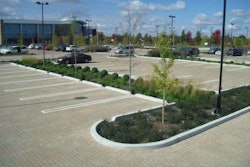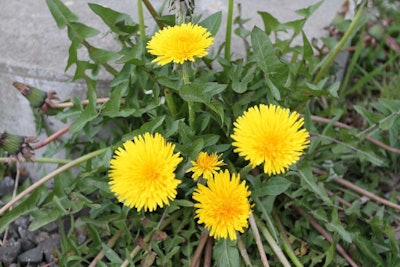
They say don’t shoot the messenger and for weeds in your clients’ yards, it is advised that you notice what message they’re conveying before you spray them into oblivion. The presence of weeds can sometimes reveal underlying conditions going on with the lawn's overall health.
Similar to how ornamental plants have their preferred growing conditions, weeds as well thrive in certain conditions so it is wise to consider what factors are allowing the certain pest to flourish. By treating the underlying problem, you can reduce the amount of time your crews will have to be out applying post-emergent herbicides.
Here are some common weeds and what their appearance can mean in a customer’s lawn:
Broadleaf plantain (Plantago major)
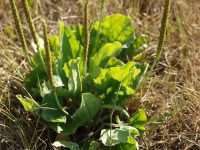 Photo: F.D. Richards/Flickr
Photo: F.D. Richards/FlickrNot to be confused with the cooking banana, this weed has broad, oval-shaped leaves and flowers that appear on leafless stalks that originate from the base of the plant. They adapt to most sites well but are particularly noted for thriving in acidic soils. They also enjoy poorly drained, compacted soils.
It is advised always to check the soil’s pH before deciding to amend it. Lime can be used to raise the soil’s pH level or you can add acid-loving plants such as hydrangeas, rhododendrons, and blueberries to shade the soil surface, making it harder for plantain seedlings to become established. If plantains are found on the lawn portion, raise your mowing height, conduct soil aeration, and avoid overwatering.
________________________________________________________
Chickweed (Stellaria media)
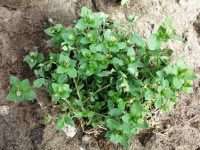 Photo: Wikipedia
Photo: WikipediaCommon chickweed is low-spreading and has a similar appearance to mouse-ear chickweed. The main difference between the two is common chickweed leaves are light green and less hairy while the other has dark green leaves that are covered in hair. When chickweed appears, it is a general indicator of highly fertile soil, but it can also indicate poor drainage or too much watering.
Chickweed can be prevented by deep, infrequent watering as well as maintaining a thick vigorous lawn. It also can be cultivated as a crop as the plant is edible and can be used in salads.
________________________________________________________
Dandelion (Taraxacum officinale)
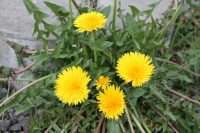 Photo: Bob Jenkins/Flickr
Photo: Bob Jenkins/FlickrOne of the most ubiquitous weeds, second to crabgrass, dandelions can grow in a number of climates, but it does prefer moist conditions and soils. Its seeds rapidly colonize disturbed soil and also thrive in weak, thin turf. They love acidic soil and it is hard to have absolute eradication of this tenacious plant.
One of the best methods of control is maintaining a healthy lawn that is able to outcompete the pest. Maintaining a proper mowing, fertilizing and irrigation schedule is the best cultural method to use, but pre-emergent herbicides are almost a must for early-season control.
________________________________________________________
Ground ivy (Glechoma hederacea)
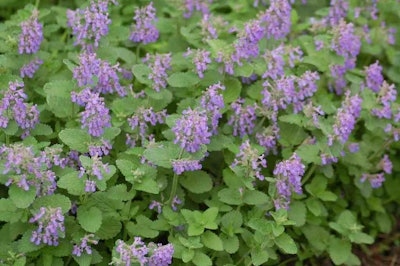 Photo: Katrina J Houdek/Flickr
Photo: Katrina J Houdek/FlickrThis low-creeping weed features rounded scalloped leaves and has small funnel-shaped flowers. It prefers moist, shady sites and is also known as “Creeping Charlie.” It is extremely common in some areas and quite difficult to control.
A combination of poor fertility, shade, and wet soils stack the odds in favor of ground ivy surviving so it is important to remedy these situations. Also by mowing at a height of 3 inches or above the turf will have a competitive advantage. Fall is a prime time for herbicide applications as well as spring.
________________________________________________________
Lambsquarters (Chenopodium album)
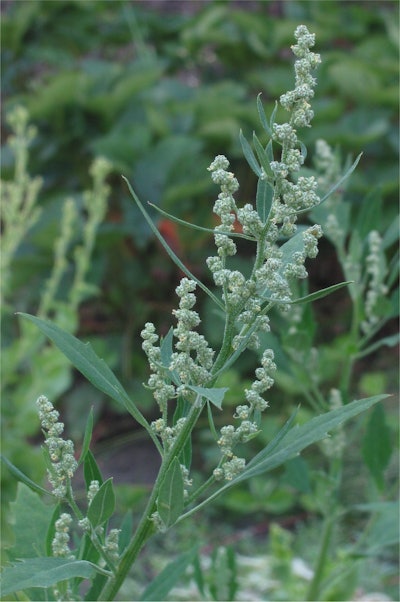 Photo: Wikipedia
Photo: WikipediaLambsquarters can be identified by its lance-shaped leaves that are pale gray-green. It can grow from a few inches to five feet. It produces tiny yellow-green flowers from May through November. It is another broadleaf weed that indicates highly fertile soil but also enjoys compacted soils.
Lambsquarters like chickweed are also edible, but if your client isn’t the adventurous type, you can aerate the lawn and reduce foot traffic to give the turfgrass a fighting chance. Consistent mowing will also cut down lambsquarters before it can produce seeds.
________________________________________________________
Prostrate knotweed (Polygonum aviculare)
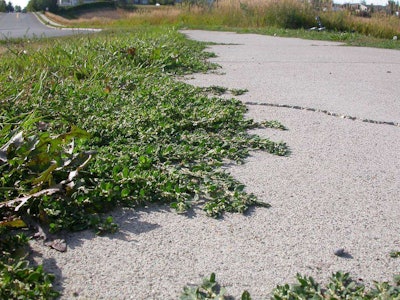 Photo: Matt Lavin/Flickr
Photo: Matt Lavin/FlickrThis is a perennial that grows from a central taproot and spreads out in a wiry system of stems and blue-green leaves that alternate. It prefers dry, hard-packed soil and can be found in pathways, sports fields, and other areas with heavy foot traffic.
Aerate the soil to relieve compaction and provide uniform watering to help grow healthy turfgrass. Well-aerated and well-fertilized lawns make it difficult for knotweed to get started.
________________________________________________________
White clover (Trifolium repens)
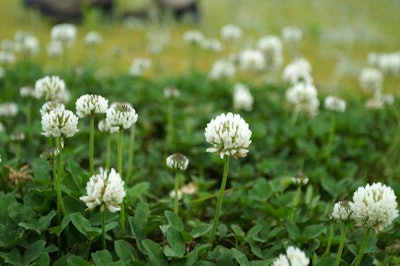 Photo: Hideyuki KAMON/Flickr
Photo: Hideyuki KAMON/FlickrWhite clover is a low-growing perennial that is easily identified with its set of three leaflets while the flowers are spikey and white. White clover can often be found when soils are low in nitrogen and where lawns are thin.
Clover is a favorite for bees so for some clients it may be better to leave the patch be, or have it serve as a lawn alternative in a location where growing turf seems nigh impossible. The other option is to improve the nitrogen levels and nurture the lawn to a healthy thickness.

